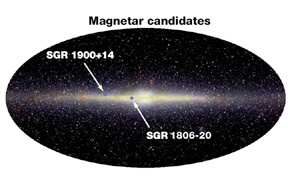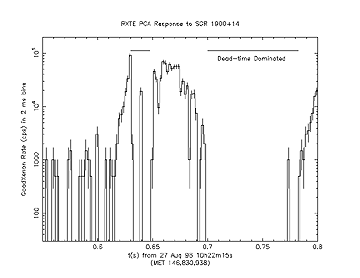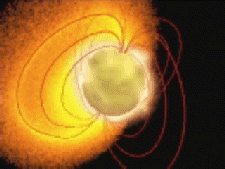RXTE Discoveries
RXTE Watches Tremendous Gamma-ray Flare Blast Earth - October 1, 1998

On August 27, 1998, an intense wave of gamma-rays emanating from a magnetar 20,000 light years away washed over the Earth. It was so powerful that it blasted sensitive detectors on seven scientific spacecraft that were in Earth orbit or elsewhere in the solar system to maximum or off-scale levels. RXTE's Proportional Counter Array (PCA) was one of those instruments that was flooded with X-rays even though it was not even pointing at this source! However, scientists say this radiation posed no health threat to humans.
How was it known that the wave of gamma-rays struck Earth? It hit the night side of the Earth, ionizing, or knocking electron electrons out of the atoms in the upper atmosphere to a level usually seen only during daytime. This ionization blast was detected by Professor Umran Inan of Stanford University. He commented, "It is extremely rare for an event occurring outside the solar system to have any measurable effect on the Earth."
The interesting think about this wave of radiation is that it came from a magnetar - a type of star only recently discovered. A magnetar is a dense ball of super-heavy matter, no larger than a city, but weighing more than the Sun. They have the strongest magnetic field in the known Universe, so strong, in fact, that it powers a steady glow of X-rays from the star's surface, which is often punctuated by brief, intense gamma-ray flashes. The one observed on August 27 was one of the more rare type of cataclysmic flares. Astronomers think that all these effects result from the magnetar's out-of-control magnetic field.
Magnetar History
The magnetar story really began in June of 1998 when a team of scientists led by Dr. Chryssa Kouveliotou of NASA's Marshall Space Flight Center, used the Compton Gamma-ray Observatory to detect a series of about 50 flashes from the star, a type called a Soft Gamma Repeater (SGR), known as "SGR 1900+14" in the constellation Aquila. During the flashing episode, Kouveliotou's team, in collaboration with Dr. Tod Strohmayer and his colleagues at NASA's Goddard Space Flight Center, pointed sensitive X-ray detectors aboard RXTE toward the star. They found faint X-rays coming from the star and pulsing in intensity every 5.16 seconds. There 5.16-second pulses had already been detected in April when Dr. Kevin Hurley of the University of California, Berkeley, aimed the Japanese/NASA Advanced Satellite for Cosmology and Astrophysics (ASCA) at the star. Comparisons of the ASCA and RXTE data showed that the X-ray pulses were gradually slowing down.
|
The implication of the source slowing, is that that it an incredibly large magnetic field. This was exactly what Dr. Robert Duncan of the University of Texas, Austin and Dr. Christopher Thompson of the University of North Carolina, Chapel Hill, predicted in 1992 when they originated the "magnetar" theory. Scientists believe that SGR 1900+14 has a magnetic field of about 800 trillion times that of Earth and 100 times stronger than any magnetic field found elsewhere in the Universe.
|  |
Before the NASA team could announce their conclusions, SGR 1900+14 emitted the tremendous flare on August 27, 1998, which was observed by almost every spacecraft with a high-energy radiation detector.

|
RXTE's Proportional Counter Array (PCA)was among the instruments that observed this burst. The light curve to the left shows that at times, the PCA was so flooded with high-energy photons from the burst, that it was virtually unable to collect any of the X-ray photons coming from the object of interest in the field of view.
|
Magnetar Formation
|
Magnetars form from the explosion (called a supernova) of a massive star. The star's center collapses under its own gravity into a dense ball of super-compressed neutrons. Because these magnetars have such incredible magnetic fields (800 trillion times that of Earth), they are unstable, the outer crust of the magnetar experiences starquakes that cause cracking and crumbling. It is the energy released in these explosive starquakes that streams out into space as intense flashes of gamma-rays. In the August 27 flare, pure magnetic energy was also released as the star's entire crust was broken to bits.
|

|
"Magnetars seem to answer several mysteries about the structure and evolution of stars," said Kouveliotou. "We think magnetars spend their first 10,000 years as Soft Gamma Repeaters. As they weaken with age and slow their rotation, they become Anomalous X-ray Pulsars -- stars that do not have enough 'juice' to flash anymore, but which emit a steady flow of X-rays for perhaps another 30,000 years. After that, they fade to black and drift for eternity through the heavens. The absence of observable pulsars in some supernova remnants just means that the pulsar's lights have gone out sooner than we expected."
Says Dr. Duncan, "A magnet this strong could erase the magnetic strip on the credit cards in your wallet or pull the keys out of your pocket from a distance halfway to the moon!"


